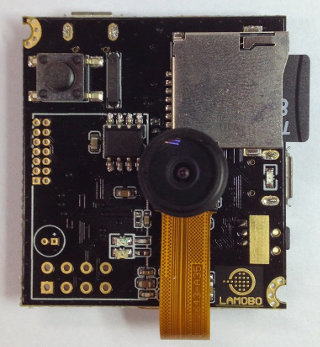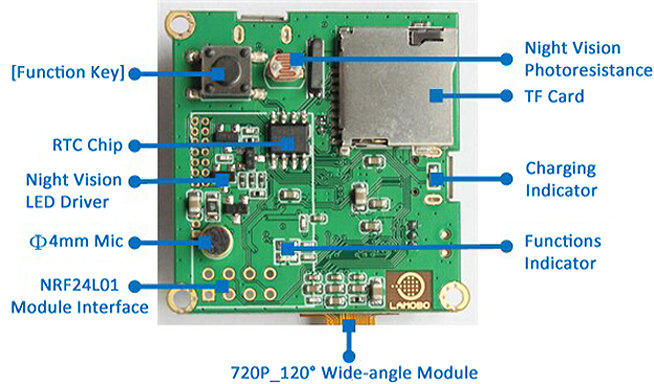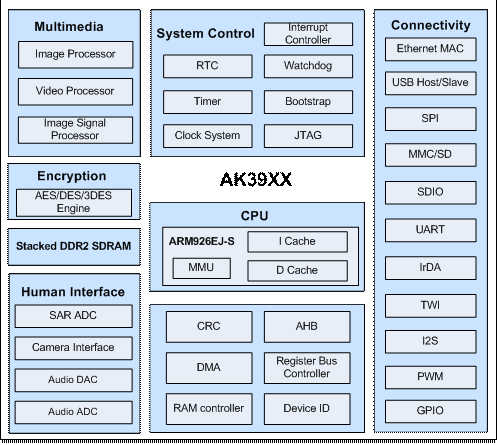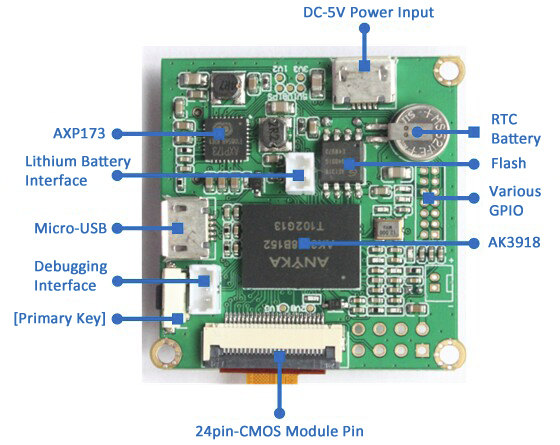SinoVoIP BPI-D1 is a tiny 720p30 camera module running Linux, and powered by Anyka AK3918 ARM9 processor. It’s a standalone module that can be powered by micro USB (5V), or an external Lithium battery, and it also includes various GPIOs, a micro USB interface, a micro SD slot to boot Linux, optional Wi-Fi connectivity, and more..

- Processor – Anyka AK3918 ARM926EJ processor @ 400 MHz
- System Memory – 64MB DDR2
- Storage – 16 MB SPI Flash + micro SD flash up to 32GB.
- Camera:
- CMOS Image Sensor 720p @ 30fps, visible light with 940 nm two-way infrared lens filter, with infrared night vision function
- Lens – M7*P0.35 EFL=3.0mm/F.NO=2.8/View Angle=60°
- Video Recording – H.264 / AVI hardware encoding at 720p 30fps for up to 120 hours of video data on a 32GB micro SD card
- Audio Formats – MP3/WMA/AAC
- Audio Input – Microphone
- Connectivity – 802.11 b/g/n (AP or client mode) with Realtek RTL8188EUS WIFI module (D1 Pro version only)
- USB – 1x micro USB OTG port, 1x micro USB port for power
- Expansion
- 14-pin header for GPIO, PWM, UART, I2C, SPI, audio in, and stereo audio out.
- 8-pin header to add NRF24L01 2.4GHz RF module
- Debugging – UART header for serial console
- Misc – RTC, function key function and charging LED, night vision photo-resistance
- Power Supply – Micro USB or external 3.7V Li-ion battery charged via AXP173 power management chip
- Power Consumption – Recording: 200 mA @ 5V; WiFi On: 350mA @ 5V; 24-hour recording is achievable with a 10,000 mAH battery
- Dimensions – 36x36mm
- Weight – 10 grams
 SinoVoIP also claims BPI-DI is an “open source” camera module, but the hardware is certainly closed, there’s no Linux kernel source on bananapi-dev github account (yet), and all they provide are the flash burning tool, and a 2MB firmware image. Luckily for us, hardware engineers often add their company name during board design, and you’ll notice a “Lamobo” marking on the botton right corner of the picture above. A quick Google Search will point to Lamodo company website, which mentions only their D1 camera module, as well as a Kickstarter campaign for the module, which was successful in terms of funding, but the goods have not been shipped yet, and the latest update (28/10/2014) is entitled “a letter of apology” (reserved to backers) which should mean delays or something worse. In any case, they also have a github account and lamobo-d1 repo with tools, Linux 3.4.15 and ip camera app source code, and the rootfs.
SinoVoIP also claims BPI-DI is an “open source” camera module, but the hardware is certainly closed, there’s no Linux kernel source on bananapi-dev github account (yet), and all they provide are the flash burning tool, and a 2MB firmware image. Luckily for us, hardware engineers often add their company name during board design, and you’ll notice a “Lamobo” marking on the botton right corner of the picture above. A quick Google Search will point to Lamodo company website, which mentions only their D1 camera module, as well as a Kickstarter campaign for the module, which was successful in terms of funding, but the goods have not been shipped yet, and the latest update (28/10/2014) is entitled “a letter of apology” (reserved to backers) which should mean delays or something worse. In any case, they also have a github account and lamobo-d1 repo with tools, Linux 3.4.15 and ip camera app source code, and the rootfs.
The Kickstarter video is still interesting, as it shows it’s light enough to be flown on a kite, and can control motors via PWM output, among other things.
SinoVoIP has not formally released the board yet and pricing information, but Lamobo D1 camera module went for $65 on Kickstarter including a 8GB micro SD card, a lens with 80-degree view angle, three USB cables for power, programming, and USB to serial, a USB type-A male connector, and an acrylic case for the board. D1 Pro version adding a Wi-Fi module went for $75. [Update: BPI-D1 can be purchased for $43 on Aliexpress]. If you are interested in making your own module with Anyka processor, you can visit Anyka AK39xx and HD IP camera solution pages.


Jean-Luc started CNX Software in 2010 as a part-time endeavor, before quitting his job as a software engineering manager, and starting to write daily news, and reviews full time later in 2011.
Support CNX Software! Donate via cryptocurrencies, become a Patron on Patreon, or purchase goods on Amazon or Aliexpress






it is available here: http://www.aliexpress.com/store/product/Freeshipment-BPI-D1-open-source-IP-camera-can-use-on-Raspberry-PI-Free-Shipment-fast-delivery/302756_32223771185.html
It’s quite interesting I have to admit !
these guys obviously will never learn what open source is 🙂
@Tsvetan
Compare to Olimex, yes, they are a joke !
I asked them on G+ a link to the “source” otherwise I’m not bying it. Let’s see if we gonna have a good laugh or not.
Heh…I’m looking at the Lamobo stuff- they don’t even have a Linux flashing solution (at least mentioned); you have to build the stuff on Linux and then use Win7 to flash the device. Fail.
@CNXSoftware Jean-Luc, you said on G+, on a BananaPi post that you find the sources ? But there is nothing right ?
@embedded_geek
It’s on lamobo-d1 github repo.
@cnxsoft
Alright I see it now! Well I give it a try so… I’ll post a review on G+ and tell you.
@embedded_geek
there is actually no Paypal paiement on Alieexpress so I will pass on that one… I don’t want to give my Visa identification. shame 🙁
it is also availble here: http://e.banana-pi.fr/fr/cameras/35-bpi-d1-camera-ip.html
But the price… 44€ VAT included. (35$ in china…)
I can’t decide if it really worth the 44€. :/
I have purchased this camera from oem sinovoip. I paid $35 usd for it. It does not have Wifi or AP as initial info stated. New version 2 documentation indicate that their is a night time IR LED module for it but where? LaMOBO video of Engineer initial setup and test show the wifi module…,its a special version that apparently is having issues leaving China or clearing customs. at the same time I received the BPi-R1 which did not include wifi antennas and the available Android image is in Chinese and crashes when you attempt to touch or press any onscreen icon in an attempt to find language option…there is a post as to this navigation
@jemartel
Did you buy it fomr here ? http://www.aliexpress.com/store/group/BPI-D1-IP-Camera/302756_259457692.html
Did you manage to make it work ? Even with the Stock firmware ?
Was intrigued and purchased one but it does not work at all. Was able to flash the new firmware but it does not record anything to the micro-sd card as documented. Given the lack of any video out, the only way to get any debugging going is to use the debug serial port on it but you need a special connecter for that.
I also tried the BPI-D1 from Ali… and really have to say: It’s a trap.
The module can use a WIFI module (or a WIFI USB dongle?) but wont have one. So this module standalone is just useless!
Since I prefer a LAN than a WLAN Camera my next try will be a Raspberry with Camera Module:
– camera of better quality
– much better software and community support
– no requirement to order from china
– no more chinese web pages to read and ‘decode’
@Robert
Hi Robert, how did you get the SSID for the Wifi, its driving me crazy…
Hi All,
I have a problem with firmware, when I log in using serial terminal, there is a error “Cannot identify ‘/dev/video0’: 2, No such file or directory”. Is there anyone having the same issue? And If you can resolve this problem, Please share with me.
Thanks in advance.